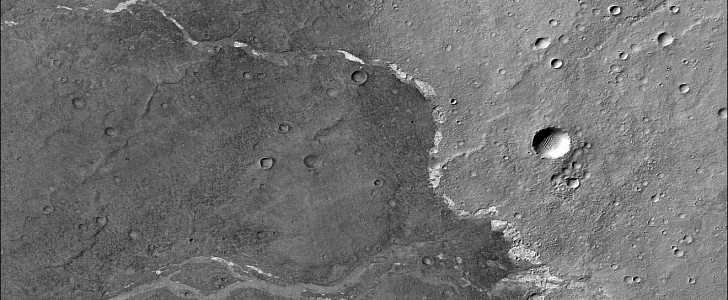NASA’s Mars Reconnaissance Orbiter (MRO) has been studying and mapping our neighbor’s surface for more than a decade, sending back stunning images of the Red Planet that unlock essential clues about its past. One image captured by the spacecraft hints that liquid water once flowed on Mars for much longer than previously thought.
Initially, scientists believed that rivers and ponds covered the surface of the Red Planet until about three billion years ago. However, recent findings show that liquid water may have been present on Mars for another billion years.
So why is this important? Researchers associate the presence of water with life, and these discoveries raise new questions about how long could have survived ancient microbes on Mars. The new study, published in AGU Advances, focuses on salt deposits left behind by water that evaporated in the Bosporos Planum region.
Using imagery and data provided by NASA’s MRO, scientists have looked at what types of landforms these salts formed on and how they were deposited across the surface. Captured in black-and-white by the orbiter’s Context Camera, the image of Bosporos Planum shows a terrain scarred by impact craters and crossed by valley networks.
The salt deposits, which appear as white specks on a dark background, have been found in valleys that were once filled with ponds. The researchers also discovered dry channels nearby, indicating that rivers carried surface runoff (from ice melting) into these ponds. They were able to date the deposits by counting the number of craters and evidence of salts on top of the landscape, suggesting that they developed as recently as 2 billion years ago.
This isn’t the first time salt minerals have been observed on Mars. They were discovered 14 years ago by NASA’s Mars Odyssey orbiter. However, the MRO is equipped with instruments that provide higher-resolution images, allowing researchers to study the surface of our neighbor in detail.
“Part of the value of MRO is that our view of the planet keeps getting more detailed over time,” said Leslie Tamppari, the mission’s deputy project scientist at NASA’s Jet Propulsion Laboratory. “The more of the planet we map with our instruments, the better we can understand its history.”
So why is this important? Researchers associate the presence of water with life, and these discoveries raise new questions about how long could have survived ancient microbes on Mars. The new study, published in AGU Advances, focuses on salt deposits left behind by water that evaporated in the Bosporos Planum region.
Using imagery and data provided by NASA’s MRO, scientists have looked at what types of landforms these salts formed on and how they were deposited across the surface. Captured in black-and-white by the orbiter’s Context Camera, the image of Bosporos Planum shows a terrain scarred by impact craters and crossed by valley networks.
The salt deposits, which appear as white specks on a dark background, have been found in valleys that were once filled with ponds. The researchers also discovered dry channels nearby, indicating that rivers carried surface runoff (from ice melting) into these ponds. They were able to date the deposits by counting the number of craters and evidence of salts on top of the landscape, suggesting that they developed as recently as 2 billion years ago.
This isn’t the first time salt minerals have been observed on Mars. They were discovered 14 years ago by NASA’s Mars Odyssey orbiter. However, the MRO is equipped with instruments that provide higher-resolution images, allowing researchers to study the surface of our neighbor in detail.
“Part of the value of MRO is that our view of the planet keeps getting more detailed over time,” said Leslie Tamppari, the mission’s deputy project scientist at NASA’s Jet Propulsion Laboratory. “The more of the planet we map with our instruments, the better we can understand its history.”





